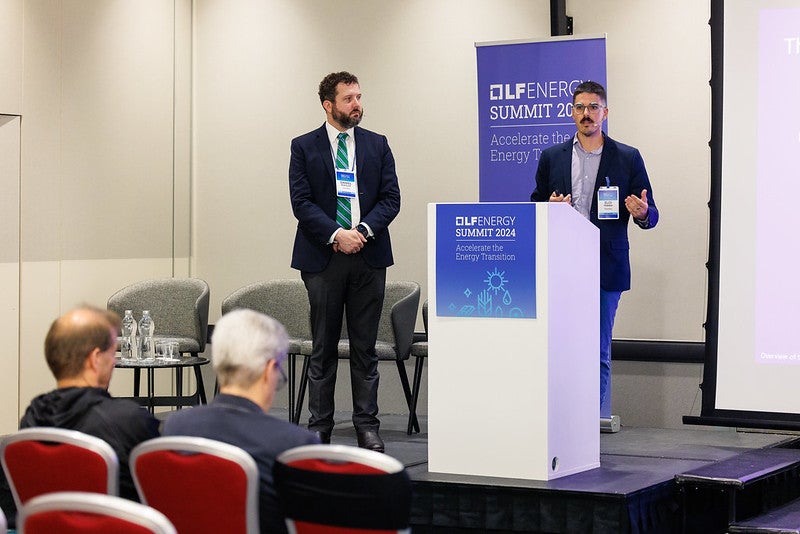LF Energy Summit Recap and Video: An Overview of the New Carbon Data Specification Consortium (CDSC) Discovery, Registration, and Customer Data Specification Drafts
At LF Energy Summit 2024 in Brussels, Daniel Roesler from UtilityAPI and Eloi Fàbrega Ferrer from Flexidao introduced the latest drafts from the Carbon Data Specification Consortium (CDSC). Their session focused on the CDSC’s efforts to create open source standards for discovering, registering, and securely accessing customer utility data. These standards, developed by CDSC working groups, aim to simplify and unify processes in the fragmented landscape of utility data. A summary of the session follows, along with the full video at the bottom of this post.
Understanding CDSC and its Structure
CDSC operates under the broader Linux Foundation and LF Energy. It consists of three primary working groups:
- Connectivity Working Group: Focuses on standardizing discovery, registration, and connectivity protocols.
- Power Systems Data Working Group: Develops data models for power systems.
- Customer Data Working Group: Establishes standards for accessing and sharing customer utility data.
This session emphasized the specifications developed by the Connectivity and Customer Data Working Groups.
Overcoming Utility Data Fragmentation
Ferrer highlighted the challenges businesses face in accessing utility data. Data is often siloed across multiple utilities or central entities, making it difficult for companies to know how to access it. The CDSC’s discovery specification solves this by creating a central system where utilities can register and advertise the data they provide.
Once a company identifies a utility, the registration process allows them to meet all the necessary requirements for integration. This seamless, standardized process reduces friction and ensures faster connectivity.
Streamlining Data Access and APIs
The key innovation in the CDSC standards is the introduction of APIs for accessing utility data. These APIs follow common protocols, such as OAuth, which is widely used for secure authorization (e.g., when signing in with Google). The CDSC specification extends OAuth to allow utilities to share data with third-party apps securely, ensuring customer consent is always involved.
Roesler elaborated on the fixed API endpoints, which allow third-party apps to interact with utility data in a structured, standardized manner. This API system also handles token management and communication between utilities and third-party services, making it easier to exchange information securely.
Real-World Use Cases
The presenters shared examples of how these standards are already empowering businesses. For instance, Flexidao uses the CDSC specifications to provide granular data for carbon accounting and 24/7 clean energy procurement. Meanwhile, Google leverages this data to track its carbon-free energy initiatives, which require precise, time- and location-specific energy data.
Standardizing Customer Data Access
The customer data specification developed by CDSC defines how third-party companies can securely request authorization to access utility data. This is essential for ensuring that sensitive customer data remains protected while allowing apps to integrate it into services like energy monitoring, billing analysis, and building benchmarking.
Utilities play a critical role in ensuring that customer consent is obtained, which is built into the API structure. The system is designed to support both simple and complex data requests, from retrieving meter information to tracking energy usage over time.
Conclusion: The Future of Utility Data Sharing
The session concluded with a call to action for other working groups and organizations to adopt the CDSC standards as the foundation for their own secure connectivity protocols. These open source specifications not only streamline utility data access but also encourage collaboration across industries, enabling a more flexible, renewable-powered grid.
The CDSC is actively developing prototypes and testing these standards, with the ultimate goal of making them part of international ecosystems like ISO and LF Energy. The success of this initiative will be key to modernizing energy infrastructure and enabling the integration of renewable energy at scale.
